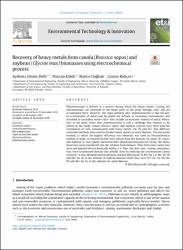| dc.contributor.author | Delil, Aydeniz Demir | en_US |
| dc.contributor.author | Köleli, Nurcan | en_US |
| dc.contributor.author | Dağhan, Hatice | en_US |
| dc.contributor.author | Bahçeci, Gizem | en_US |
| dc.date.accessioned | 2020-06-03T10:09:49Z | |
| dc.date.available | 2020-06-03T10:09:49Z | |
| dc.date.issued | 2020 | en_US |
| dc.identifier.citation | Delil, A. D., Koleli, N., Daghan, H., & Bahceci, G. (2020). Recovery of heavy metals from canola (Brassica napus) and soybean (Glycine max) biomasses using electrochemical process. Environmental Technology & Innovation, 17, 11. doi:10.1016/j.eti.2019.100559 | en_US |
| dc.identifier.issn | 2352-1864 | |
| dc.identifier.uri | http://dx.doi.org/10.1016/j.eti.2019.100559 | |
| dc.identifier.uri | https://hdl.handle.net/20.500.12294/2470 | |
| dc.description.abstract | Phytoextraction is defined as a process during which the heavy metals, causing soil contamination, are conveyed to the green parts of the plant through roots and are accumulated there. However, the main problem after phytoextraction is that because of accumulation of metal ions by plants are defined as secondary contaminants and classified as hazardous wastes since they include an excessive amount of metal. Hence, how to use plant waste after phytoextraction is still a challenge that remains to be solved. In this study, canola (Brassica napus) and soybean (Glycine max) were used for remediation of soils contaminated with heavy metals (Cd, Pb and Zn). Two different extraction methods were used to dissolve heavy metals in waste biomass. The extraction method, in which the highest efficiency was obtained, was used an electrochemical method in order to remove recover toxic metals from the biomass of canola (B. napus) and soybean (G. max) plants, harvested after phytoextraction process. Firstly, the heavy metal ions were transferred into the solution from biomass. Then these toxic metal ions were precipitated electrochemically within 2 h. Thus, the toxic ions, causing contamination, were transformed directly into metallic form by reducing the concentration (metal recovery). It was obtained electrochemical removal efficiencies of 80% for Cd, 94% for Pb and 68% for Zn in the solution of soybean biomass while they were 97% for Cd, 99% for Pb and 46% for Zn in the solution of canola biomass. (C) | en_US |
| dc.language.iso | eng | en_US |
| dc.publisher | Elsevier | en_US |
| dc.relation.ispartof | Environmental Technology & Innovation | en_US |
| dc.identifier.doi | 10.1016/j.eti.2019.100559 | en_US |
| dc.identifier.doi | 10.1016/j.eti.2019.100559 | |
| dc.rights | info:eu-repo/semantics/openAccess | en_US |
| dc.subject | Combined System | en_US |
| dc.subject | Contaminated Biomass | en_US |
| dc.subject | Electrodeposition | en_US |
| dc.subject | Hyperaccumulator Plants | en_US |
| dc.subject | Phytoremediation | en_US |
| dc.subject | Potential Toxic Metals | en_US |
| dc.title | Recovery of heavy metals from canola (Brassica napus) and soybean (Glycine max) biomasses using electrochemical process | en_US |
| dc.type | article | en_US |
| dc.department | Mühendislik ve Mimarlık Fakültesi, İnşaat Mühendisliği Bölümü | en_US |
| dc.identifier.volume | 17 | en_US |
| dc.identifier.startpage | 1 | en_US |
| dc.identifier.endpage | 11 | en_US |
| dc.relation.publicationcategory | Makale - Uluslararası Hakemli Dergi - Kurum Öğretim Elemanı | en_US |
| dc.relation.tubitak | info:eu-repo/grantAgreement/TUBITAK/SOBAG/115Y337 | |


















